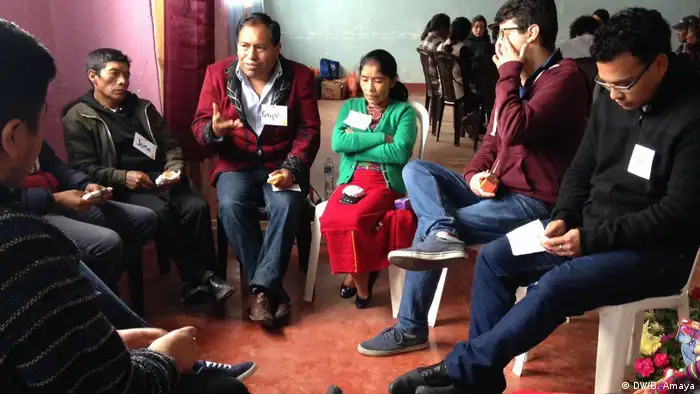Latin America
Reconciliation in post-civil war Guatemala – a journey into the past
Hundreds of thousands of people were murdered in Guatemala during the 36-year civil war that ended in 1996. Just recently, university students met living witnesses of that era as part of a DW Akademie project.
A candle burns in the middle of the room; next to it are flowers on the concrete floor. A group of young people are sitting on white plastic chairs in a circle and listening to a man who talks about the past. Felipe Itzep (48) speaks clearly and watches his listeners as though he were trying to make sure he understood them. He recounts how he spent five years living in the mountains together with the other inhabitants of his village. "It was cold up there and our clothes were always wet. We were afraid of the soldiers. They looked for us and shot at us because they thought we were guerrilla fighters. One day, planes flew by and dropped bombs. My grandmother died in the attack."
Felipe's village Xix, an 11-hour bus ride from the capital, was the scene of serious crimes. In the 1980s, soldiers murdered over a hundred of its inhabitants. Today, Felipe is talking about those days in the primary school of his village. His listeners are 16 university students from the Universidad Rafael Landivar in Guatemala City. They are visiting Xix for two days as part of a project run by DW Akademie. Felipe himself is now involved in the indigenous rights organization Ajkemab.
Digital "Map of Memory" documents memorial sites
For the students, it is a journey into the past. Guatemala went through civil war between 1960 and 1996. Nearly 250,000 people were killed, including many indigenous people. The Guatemalan military and paramilitary troops burned entire villages. Tens of thousands of people disappeared and to this day, no one knows what happened to most of them.
The euphoria following the peace treaty in 1996 quickly vanished and gave way to silence. With the exception of a few court trials, the crimes committed during the civil war are not discussed in public or the media. The civil war era is not taught as part of school or university curricula. This is where the "Map of Remembrance" comes in. It is a digital project run by DW Akademie and its partner "Memorial para la Concordia." The interactive map links places that have civil war memorials - from commemorative plaques and monuments to murals.
People from all over the country photograph and document these places. "Their work is important because most Guatemalans born in the last twenty years know little or nothing about the civil war," says project manager Bettina Amaya. "And yet this past still haunts us today." The country has not found true peace. Weapons are still part of everyday street scenes in the capital and the murder rate is so high that just as many people die today as they did during the civil war.
Journey into the past: Two worlds meet in Xix
The young people from the University of Landivar first worked on the memory map. That was when they came up with the idea for the journey. "Usually, students in the cities rarely meet the rural population," says Johannes Metzler, who works locally as DW Akademie's country manager. "It is another world."
At the end of the two-day meeting, villagers and students celebrated a Mayan ceremony to honor the dead. For two hours, the guests from the capital learned about the villagers' ideas about the connection between the village community and nature, respect for life and how important it is not to forget the past in order to be able to shape the future.
"For me, the eyewitness testimonies were shocking," recalls Juan José Pinzón (20), who studies international relations. "I never thought these things happened in my country. I want to get involved so that something like this will never happen again."
DW recommends
- Date 21.12.2017
- Author Paul Zimmer, Johannes Metzler
- Feedback: Send us your feedback.
- Print Print this page
- Permalink https://p.dw.com/p/2pmcS
- Date 21.12.2017
- Author Paul Zimmer, Johannes Metzler
- Send us your feedback.
- Print Print this page
- Permalink https://p.dw.com/p/2pmcS

